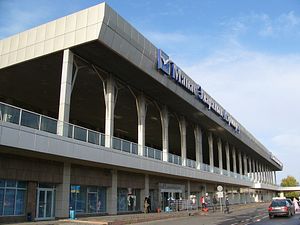On the morning of January 16, Manas International Airport outside Bishkek, Kyrgyzstan was cloaked in thick fog. At 7:31 am, tragedy struck when a cargo plane — flying from Hong Kong and stopping en route to Istanbul — reportedly overshot the runway and crashed into the village of Dacha-Suu. The plane’s four crewmembers and 35 villagers, many of them children, were killed.
In the weeks after the crash, as Kyrgyzstan processed through grief and the inevitable questions that come after tragedies — what happened and why — and the authorities investigated and clarified, the conversation turned to corruption.
Initial reports pegged the plane as a cargo flight, stopping to refuel in Bishkek before continuing on to its final destination in Turkey. The flight — THY6491 — was on a Turkish Airlines route, but wasn’t a Turkish Airlines flight. The scheduled cargo flight was being operated by ACT Airlines, a Turkish airline which goes by the name MyCargo.
A transport official, quoted by The Sun, said, “At the landing it didn’t come down on the runway, [but] flew over it; its fuselage touched the fence and after that it crashed.”
Residents of the village interviewed by the AP had horrific memories of the early morning disaster. “We heard a roar and [what felt] like an earthquake. Many people were sleeping, everything around was burning. One of the parts of the aircraft fell on our neighbor’s house. She and her whole family died,” one woman said.
According to RFE/RL, Kyrgyz authorities said the flight crew had flown the route before. Poor visibility and pilot error were cited almost immediately as causes and there’s no reason to doubt that assessment. But there may be more to the tragedy, not in why the plane crashed but what it was doing landing in Bishkek to begin with and what happened after it hit the ground.
In a detailed report this week, RFE/RL parses through the aftermath and questions following the crash. The plane’s cargo lay scattered amid the destroyed homes and in the frozen streets of Dacha-Suu: “charred remnants of iPhones, luxury cigarette lighters, and other electronic gadgets…”
Footage of a Kyrgyz RFE/RL correspondent walking the streets of Dacha-Suu and stooping to pick up the torn remains of what looks like a user manual, is more damning than one would assume when he starts reading. The manual — for a Condor cell phone — says “Made in China” in Russian, but the directions are in Kyrgyz.
“It’s the first time I’ve seen something made in China with a manual in Kyrgyz,” he remarks.
In other footage, a villager tells of her sister seeing a police car back up to the wreckage and load the car with stuff from the plane. Others say that looting occurred as soon as the plane crashed, including by first responders.
Omurbek Tekebayev, a prominent politician and head of the Ata-Meken faction in parliament, commented that “Some goods found at the crash site deepen our suspicions.” Tekebayev is deputy chairman of the 11-member parliamentary commission formed to look into the circumstances of the flight and crash. “[T|here is a basis to suspect that there is systematic smuggling going on at [Manas] airport” he said.
The airline operating the flight and Kyrgyz authorities have offered contradictory statements about what, exactly, the plane was doing in Bishkek. Was it stopping to refuel or was it stopping to unload cargo?
An assistant manager at ACT Airlines told RFE/RL on January 18 that the plane was to unload cargo in Bishkek, and a press release the next day said the plane had enough fuel to fly direct from Hong Kong to Istanbul. But on January 19, the deputy director-general of MyCargo Airlines, Hamza Tiglay, said the plane was stopping to refuel and not scheduled to unload any cargo. Manas officials say the same thing, that the flight was stopping for fuel, but as RFE/RL points out, “they have declined to provide flight records or other documents to back that claim.” Further, Tekebayev says they haven’t provided information to the parliamentary commission either.
MyCargo, according to Transport Minister Jamshitbek Kalilov, is not approved to deliver or pick up goods in Kyrgyzstan and only received a license to land for “technical reasons” in Kyrgyzstan in September.
If the plane’s cargo was indeed not intended to be offloaded in Bishkek, why were there cell phone manuals in Kyrgyz? The answer may be simple: do Chinese-made cellphones sold in Turkey usually come with Kyrgyz directions, in the way that cellphones sold in the United States come with Spanish and French directions? (Feel free to get back to me if you know…) If not — and that is the implication of the RFE/RL report — the Dacha-Suu tragedy may have inadvertently peeled back the cover on smuggling operations through Manas. Few would be surprised if that turns out to be the case.

































